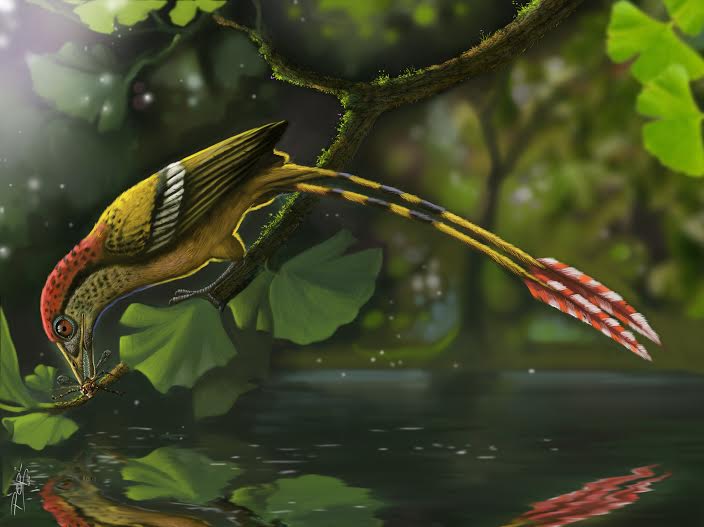The 115-million-year-old remains of a tiny toothed bird with a two-pronged tail resembling a pair of darts have filled significant knowledge gaps about feather evolution, providing profound insights into the early diversity and distribution of avian species. This groundbreaking discovery, reported by scientists, has unveiled a remarkable 3-D specimen from northeast Brazil, making it the oldest bird fossil yet discovered from Gondwana, the ancient supercontinent that eventually fragmented into today’s southern landmasses.
Prior to this finding, birds with such a unique and now extinct tail design were exclusively known to have lived in China during this period of Earth’s history, which was distinct from Gondwana. The newfound bird, characterized by its small size akin to a hummingbird, prominent eyes, plumes enveloping the body, and distinctive two long feathers in its tail, adds a new dimension to our understanding of avian evolution during the Early Cretaceous era.
Measuring approximately six centimeters from the tip of its nose to the beginning of its double-shafted, ribbon-like tail, this unnamed bird belonged to the Enantiornithes group, characterized by their possession of teeth and clawed wings. Interestingly, members of this group are not believed to have left any living descendants, making their fossils crucial windows into the ancient avian world.
What makes this fossil particularly exceptional is its preservation in three dimensions, unlike many ancient specimens that are often flattened by geological processes. This preservation allowed researchers to glean detailed information about the bird’s anatomy, including its body shape, feather structure, and potentially even color patterns, offering insights into its likely appearance and behavior.

Among the intriguing findings were rows of spots distributed symmetrically along the tail feathers, hinting at a possible color pattern that may have had roles in camouflage, sexual display, or species recognition. While modern birds primarily use feathers for flight and insulation, the distinctiveness of these tail feathers suggests alternative functions such as visual communication or mate attraction in ancient birds.
The presence of teeth in the bird’s beak is another notable feature, highlighting an evolutionary stage where birds still retained dentition, unlike their toothless descendants seen today. Understanding the transition from toothed ancestors to toothless modern birds is a crucial aspect of avian evolution, shedding light on adaptations related to feeding strategies and beak evolution.
This discovery also contributes to our knowledge of the geographic distribution of early avian species. The presence of a bird with such unique features in Gondwana challenges previous notions about the distribution of ancient birds and underscores the complexity of avian evolution across different continents during the Mesozoic era.
In the broader context of feather evolution, this fossil serves as a valuable piece of the puzzle. Feathers are complex structures that have evolved for various functions, including flight, insulation, display, and communication. Studying ancient feathers and their diversity across different bird groups provides crucial insights into the adaptive significance of feathers throughout evolutionary history.
The Enantiornithes group, to which this bird belonged, represents a fascinating branch in avian evolution. Their possession of teeth, clawed wings, and distinct feather arrangements sets them apart from modern birds, offering a glimpse into the diversity of avian forms that existed in the past. By studying these ancient bird fossils, scientists can trace the evolutionary pathways of avian traits and better understand the factors driving avian diversification.
Furthermore, this discovery adds nuance to our understanding of the earliest known relatives of birds. While Archaeopteryx is generally considered a transitional species from non-avian dinosaurs to birds, the presence of diverse bird forms like the Enantiornithes group highlights the complexity of avian evolution during the Mesozoic era.
The study appears in the journal Nature Communications.
